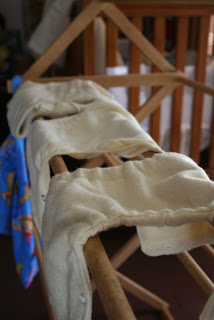Anwen asked,
I am interested in old-fashioned diapers for the sake of the environment, but...is it cheaper?
The answer is almost always, "Yes!" Cloth diapering can be as simple or as complex, as inexpensive or as expensive as you like!
Prefolds and simple
PUL covers like
Bummis or
Thirsties are the most inexpensive option. Depending on size, a dozen
prefolds costs between $21 for newborn to $36 for toddler (you'd need 2-4 dozen depending on how often you wash and baby's age). Simple
PUL covers are $11-$13 each and you'd need 4-6.
That would probably break down something like this using
Green Mountain prefold prices and estimating $12/cover:
Newborn
3 dozen
prefolds- $63
6 covers- $72
Infant
3 dozen
prefolds- $81
4 covers- $48
Older Infant/Toddler
3 dozen
prefolds- $96
4 covers- $48
Total $408.
Now let's say you buy some wipes rather than make some ($55.80), wipe solution ($14.95), a diaper pail liner for home ($18) and a small wet bag ($12.95) for your diaper bag.
That makes your total $509.70.
Another popular option are all-in-one, one-size diapers like
BumGenius. These are another fairly inexpensive option over the course of a cloth diapering "life span," but are more expensive at the outset as they typically run $20+. A friend of mine has been using
BumGenius one-size pockets on her daughter since about 6 weeks. She has 30 and spent approximately $538.50.
Add in the extras above and that makes $640.20.
I've never bought disposable diapers or wipes (well, I think one pack of
sposies when M. was first born) so I can't say what the average cost is exactly, but today on
Mothering someone said her friend spent $200/month on wipes and diapers. Now I have no idea how many children that mother has in diapers, how old they are or where she shops, but let's assume that's a fair estimate. Considering the average child wears diapers for 2-3 years that's somewhere in the neighborhood of $4800-7200. Yikes!
Of course, you may have to consider the extra money to wash and dry diapers. We have our own well and septic system now, but when our first baby was born we were on town water. We generally washed diapers three times a week and saw an increase of
around $10 over a three-month period in our water bill, so that would have been $40/year or $120 over three years if we had a late potty learner. I do not remember if our electric changed at all. In those days I didn't line dry at all so the increase was probably minimal since we already had lots of dryer usage. Definitely not too significant when compared to the cost of disposables.
Now I have heard people who live in arid regions make the argument that increased water usage for cloth is not environmentally friendly but I'm still not sure how that would balance over plastic diapers in landfills. I'll confess that while we cloth diaper for cost reasons and because it's more earth-friendly, my primary motivation is because it's better for my babies!
For our first son, we spent roughly the amount in scenario two above. Two sets of
Fuzzi Bunz at approximately $300 each, two dozen wipes, a diaper pail liner, a wet bag, and a
diaper sprayer for the toilet (though ours was no where NEAR $45!). We had planned on that being IT, at least for baby number two but as I explained previously several things happened: 1) he didn't fit into the small
FBs and 2) the mediums were utterly worn out from 18 months of nonstop use.
So...our second baby started out with three dozen
prefolds and four covers as in scenario one. We also bought a pack of
Snappis, a new bottle of wipe solution, and one more diaper pail liner. We are reusing our wipes, etc.
Once he grew out of those,
however, the crazy diaper trials and the
buying, selling, and swapping began! We've spent a LOT getting to where we are, but I've been able to sell most of what we didn't like (for almost full price) or gift it to friends/family...and then buy more to try!
I'd say our current stash (not including the accessories we already had on hand) cost about $650. Keep in my mind I use only natural fibers, some organic, and all our covers are wool. I'm expecting this to last us through potty training. So in new diapers for this baby we've spent around $800. This makes our total investment over three years around $1400. With slight increases in water and electrical usage let's say $1500. Not bad! It could be done for a LOT less, but also a lot more. Did you know there are custom-made fitted
diapers out there that can run $50 EACH?? I want my babies'
tushies to be comfy, clean, and away from nasty chemicals but that is stretching it a bit (in my opinion, of course)!
For anyone trying to sort through the world of cloth diapering,
Diaper Pin is a great
place to start. I always check out their product reviews before I buy anything!

















